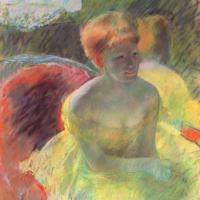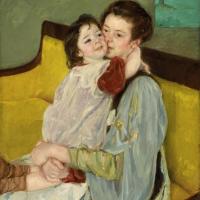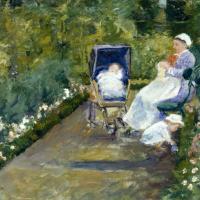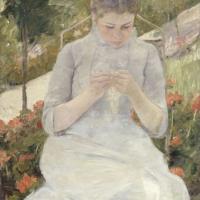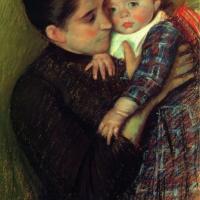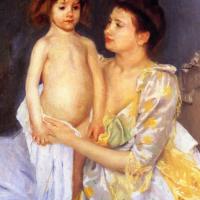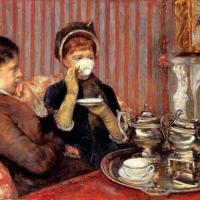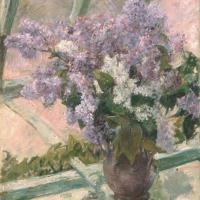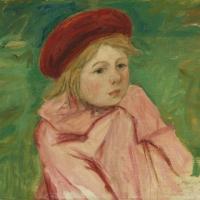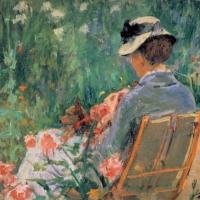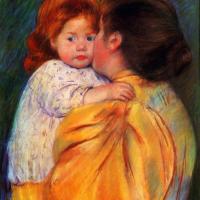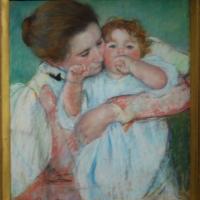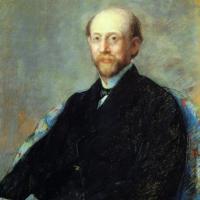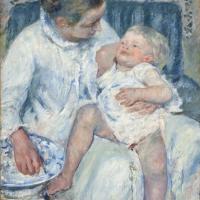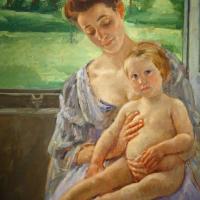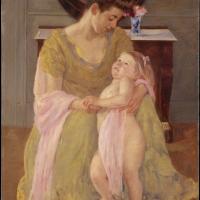Mary Cassatt
A Caress
$480.00
A Woman And A Girl Driving
$480.00
At The Theater 1879
$480.00
Caresse Maternelle
$480.00
Charles Dikran Kelekian
$480.00
Children In A Garden
$480.00
Fran Oise In A Round
$480.00
Girl In The Garden
$480.00
Helene De Septeuil
$480.00
Le The
$480.00
Lilacs In A Window
$480.00
Little Girl In A Red Beret
$480.00
Margot
$480.00
Margot In White
$480.00
Mary Cassatt
$450.00
Mary Pink Sash
$480.00
Maternal Kiss
$480.00
Mere Et Enfant Sur Fond Vert
$480.00
Moise Dreyfus
$480.00
Mary Cassatt
Mary Cassatt (1844-1926)
Mary Stevenson Cassatt (May 22, 1844 – June 14, 1926) was an American painter and printmaker. She was born in Allegheny City, Pennsylvania (Now part of Pittsburgh's North Side), but lived much of her adult life in France, where she first befriended Edgar Degas and later exhibited among the Impressionists. Cassatt often created images of the social and private lives of women, with particular emphasis on the intimate bonds between mothers and children. She was described by Gustave Geffroy in 1894 as one of "les trois grandes dames" (the three great ladies) of Impressionism alongside Marie Bracquemond and Berthe Morisot.
Cassatt was born in Allegheny City, Pennsylvania, which is now part of Pittsburgh. She was born into an upper-middle-class family: Her father, Robert Simpson Cassat (later Cassatt), was a successful stockbroker and land speculator. He was descended from the French Huguenot Jacques Cossart, who came to New Amsterdam in 1662. Her mother, Katherine Kelso Johnston, came from a banking family. Katherine Cassatt, educated and well-read, had a profound influence on her daughter. To that effect, Cassatt's lifelong friend Louisine Havemeyer wrote in her memoirs: "Anyone who had the privilege of knowing Mary Cassatt's mother would know at once that it was from her and her alone that [Mary] inherited her ability."
Cassatt grew up in an environment that viewed travel as integral to education; she spent five years in Europe and visited many of the capitals, including London, Paris, and Berlin. While abroad she learned German and French and had her first lessons in drawing and music. It is likely that her first exposure to French artists Jean Auguste Dominique Ingres, Eugène Delacroix, Camille Corot, and Gustave Courbet was at the Paris World's Fair of 1855. Also in the exhibition were Edgar Degas and Camille Pissarro, both of whom were later her colleagues and mentors.
Though her family objected to her becoming a professional artist, Cassatt began studying painting at the Pennsylvania Academy of the Fine Arts in Philadelphia at the early age of 15. Impatient with the slow pace of instruction and the patronizing attitude of the male students and teachers, she decided to study the old masters on her own.
Cassatt decided to end her studies: At that time, no degree was granted. After overcoming her father's objections, she moved to Paris in 1866, with her mother and family friends acting as chaperones. Since women could not yet attend the École des Beaux-Arts, Cassatt applied to study privately with masters from the school and was accepted to study with Jean-Léon Gérôme, a highly regarded teacher known for his hyper-realistic technique and his depiction of exotic subjects.
Toward the end of 1866, she joined a painting class taught by Charles Chaplin, a noted genre artist. In 1868, Cassatt also studied with artist Thomas Couture, whose subjects were mostly romantic and urban.
Returning to the United States in the late summer of 1870—as the Franco-Prussian War was starting—Cassatt lived with her family in Altoona. Her father continued to resist her chosen vocation, and paid for her basic needs, but not her art supplies. Cassatt placed two of her paintings in a New York gallery and found many admirers but no purchasers.
Cassatt traveled to Chicago to try her luck, but lost some of her early paintings in the Great Chicago Fire of 1871. Shortly afterward, her work attracted the attention of the archbishop of Pittsburgh, who commissioned her to paint two copies of paintings by Correggio in Parma, Italy, advancing her enough money to cover her travel expenses and part of her stay.
Cassatt's popular reputation is based on an extensive series of rigorously drawn and tenderly observed paintings and prints on the theme of the mother and child. The 1890s were Cassatt's busiest and most creative time. She had matured considerably and became more diplomatic and less blunt in her opinions. She also became a role model for young American artists who sought her advice. Among them was Lucy A. Bacon, whom Cassatt introduced to Camille Pissarro. Though the Impressionist group disbanded, Cassatt still had contact with some of the members, including Renoir, Monet, and Pisarro. In 1891, she exhibited a series of highly original colored drypoint and aquatint prints, including Woman Bathingand The Coiffure, inspired by the Japanese masters shown in Paris the year before. Also in 1891, Chicago businesswoman Bertha Palmer approached Cassatt to paint a 12' × 58' mural about "Modern Woman" for the Women's Building for the World's Columbian Exposition to be held in 1893. As the new century arrived, Cassatt served as an advisor to several major art collectors and stipulated that they eventually donate their purchases to American art museums.
A trip to Egypt in 1910 impressed Cassatt with the beauty of its ancient art, but was followed by a crisis of creativity; not only had the trip exhausted her, but she declared herself "crushed by the strength of this Art", saying, "I fought against it but it conquered, it is surely the greatest Art the past has left us ... how are my feeble hands to ever paint the effect on me." Diagnosed with diabetes, rheumatism, neuralgia, and cataracts in 1911, she did not slow down, but after 1914 she was forced to stop painting as she became almost blind.
Cassatt died on June 14, 1926 at Château de Beaufresne, near Paris, and was buried in the family vault at Le Mesnil-Théribus, France.
Cassatt’s Legacy:
Mary Cassatt inspired many Canadian women artists who were members of the Beaver Hall Group.
The SS Mary Cassatt was a World War II Liberty ship, launched May 16, 1943.
A quartet of young Juilliard string musicians formed the all-female Cassatt Quartet in 1985, named in honor of the painter. In 2009, the award-winning group recorded String Quartets Nos. 1–3 (Cassatt String Quartet) by composer Dan Welcher; the 3rd quartet on the album was written inspired by the work of Mary Cassatt as well.
In 1966, Cassatt's painting The Boating Party was reproduced on a US postage stamp. Later she was honored by the United States Postal Service with a 23-cent Great Americans series postage stamp.
In 1973, Cassatt is inducted into the National Women's Hall of Fame.
In 2003, four of her paintings (Young Mother (1888), Children Playing on the Beach (1884), On a Balcony (1878/79) and Child in a Straw Hat (circa 1886)) were reproduced on the third issue in the American Treasures series.
On May 22, 2009, she was honored by a Google Doodle in recognition of her birthday.
Cassatt's paintings have sold for as much as $4 million, the record price of $4,072,500 being set in 1996 at Christie's, New York, for In the Box.
A public garden in Paris is named 'Jardin Mary Cassatt' in her memory in the 12th arrondissement of the French capital.




